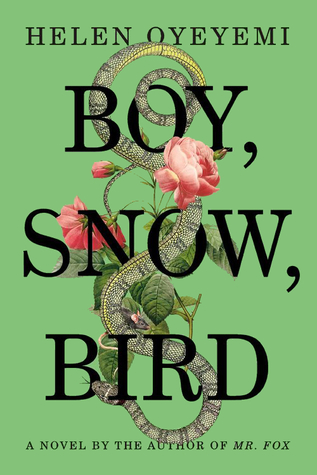Boy, Snow, Bird: A Novel
- By Helen Oyeyemi
- Riverhead Books
- 320 pp.
- Reviewed by Nathan Blanchard
- March 19, 2014
A family’s secrets run deep in this loose retelling of “Snow White.”

It’s 1953. Boy Novak is fleeing an abusive father in New York City when she arrives in Flax Hill, Mass., to begin a new life. Working at a bookstore and living in a boarding house, she’s soon surrounded by new friends with small-town temperaments. She marries a widower named Arturo Whitman and becomes stepmother to his enchanting daughter, Snow.
Arturo’s mother and siblings accept Boy into the family, albeit brusquely and without much ceremony. Olivia, the matriarch, is particularly cold and intimidating from the outset. Boy’s first conversation with her, when Olivia’s daughter Vivian is present, sets the tone: “Then she asked me what I wanted to do with my life. I said: ‘Oh I like it at the bookstore,’ and Vivian and Olivia gave each other the briefest but most chilling glance, then changed the subject.”
Boy gives birth to her own daughter, Bird. The child’s dark skin exposes the Whitmans’ secret: They are light-skinned African-Americans posing as whites. Boy exiles the adolescent Snow to live with a distant aunt. The exact motive for the banishment is unclear, though it may be because Boy fears that Bird will have a difficult childhood in the shadow of her beautiful—and white—sister.
Bird grows up in a family replete with racial tension while Arturo, Boy, and Olivia engage in parental power struggles. The girl eventually becomes curious about her estranged older sister, which prompts a reunion between Snow and the Whitmans that forces all members to confront their issues.
Oyeyemi divides the narrative into three parts: Boy’s perspective starting with her own childhood and ending when she banishes Snow; Bird’s perspective as a preteen, involving a series of letters between herself and Snow; and once again Boy’s point of view in narrating the book’s shocking climax. Each woman has a distinct voice, and the toggle between their different points of view galvanizes the storytelling with new narrative threads that spiral ever outward. The book struggles to bind these threads into a focused and cohesive whole, but readers can easily stay grounded, carried along by Oyeyemi’s crystalline style and vivid imagination.
Boy narrates with clear and direct language. “Getting pushed around as a kid had made me realistic about my capabilities. I know some people learn how to take more knocks and keep going. Not me. I’m the other kind.” Her vernacular pops with a scruffy personality, but as she comes of age she unveils deeper concerns that add dimension to her character: “This doesn’t feel like my life, it feels like somebody else’s. I’m standing here holding somebody else’s life for them, trying to keep it steady while it bobs up and down like a ferocious balloon.” However easily her story reads, she cannot be reduced to simple charm. Oyeyemi allows Boy a range of emotional dithering and uncertainty that makes for some confusing and frustrating decisions.
Boy’s decision to send Snow away to live with relatives offers an example. Even though the section is written in first-person, Boy never shares her rationalization or justification for that watershed moment. Adding to the mystery is an absence of dialogue between Boy and Arturo to explain his acquiescence in sending his own daughter away. These holes feel intentional, allowing readers to provide possible reasons for characters’ decisions and in turn feel ambivalence toward them. For the most part, this ambivalence makes the characters feel alive and complicated, but when it doesn’t work they feel capricious.
In contrast, Bird is more verbose about her feelings and perceptions, with readers sometimes given a moment-to-moment report of her thoughts. Employing a technique her mother also uses at times, Bird refers to herself in the third person to distance herself from her emotions: “Bird sleeps in the same room Snow used to sleep in. Wait … there might be something to that. The mirror stuff only tends to happen in a handful of places.”
Oyeyemi tackles an array of themes—child abuse, racial identity, gender roles, appearances, nontraditional family dynamics—and while each aspect is intriguing, readers might feel enervated by too many unresolved storylines. For example, throughout the book Boy is involved in a love triangle, but the significance of this subplot and how it influences the book as a whole remains unclear because it is never connected to a larger idea or theme. Instead, this subplot fizzles out when other plot elements are introduced. Still, many readers will appreciate Oyeyemi’s respect for ambiguity and inconclusiveness.
Ostensibly, Boy, Snow, Bird retells “Snow White,” but the relationship between these two stories is insignificant. They share a few motifs, like misbehaving stepmothers and concerns for beauty and vanity, but the similarities are not specific enough to warrant the more superficial connections that Oyeyemi imposes, like references to mirrors and a character named “Snow.” These cute nods to “Snow White” are merely that: cute.
Retelling fairy tales is dicey business, and Boy, Snow, Bird feels instead like its own story, derivative of nothing. Readers wanting a sprawling tale of family secrets will be satisfied as long as they are content to let the characters keep secrets from them as well.
Nathan Blanchard’s work has appeared in District Lines and McSweeney’s Internet Tendency, and he regularly contributes web content for the Potomac Review. He enjoys eating at Mexican restaurants with his wife.

